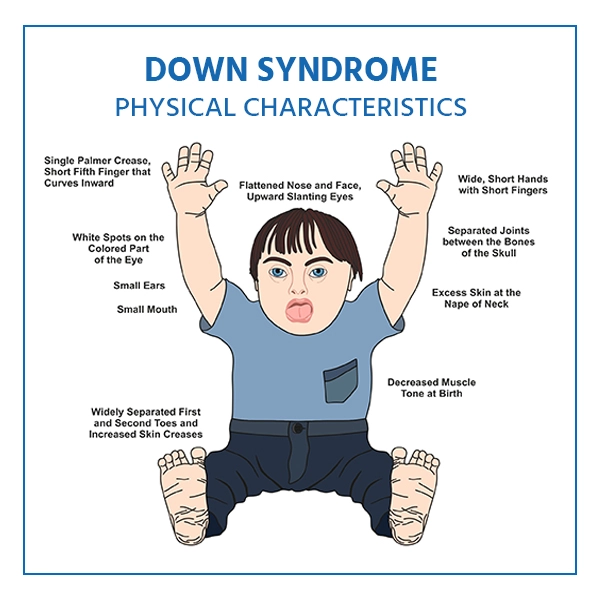What is Down Syndrome?
Down syndrome or Down's syndrome is a common chromosomal abnormality that occurs when a person has a part or a full extra copy of chromosome 21. It is also known as trisomy 21.
It is the most common congenital anomaly involving physical, mental, and functional issues. It includes increased risks of health problems due to the presence of a third gene instead of the normal two chromosomes 21.
Types of Down syndrome
There are three types
- Trisomy 21
- Translocation Down syndrome
- Mosaic Down syndrome

Down syndrome symptoms
- Distinctive facial features, such as
- Small head
- Flattened face
- Short neck
- Protruding tongue
- Palpebral fissures - Upward slanting eye lids
- Congenital heart defects
- Atrioventricular septal defect (AVSD)
- Ventricular septal defect (VSD)
- Secundum atrial defect
- Tetralogy of Fallot
- Isolated PDA
- Gastrointestinal (GI) abnormalities
- Hirschsprung disease
- Intestinal obstruction
- Duodenal atresia
- Imperforate anus
- Gastroesophageal reflux (GERD)
- Hematological disorders
- Transient abnormal myelopoiesis (TAM) or transient leukemia
- Neutrophilia
- Thrombocytopenia
- polycythemia
- Neurologic Disorders
- Intellectual disability
- Less concentration
- Seizures
- Myoclonic seizures
- Lennox-Gestaut syndrome
- Dementia
- Endocrinological Disorders
- Thyroid gland dysfunction
- Hypothyroidism
- Hyperthyroidism (rare)
- Delayed puberty
- Primary hypogonadism (in girls)
- Cryptorchidism, micropenis, ambiguous genitalia, small testes low sperm count and less pubic hair. (in boys)
- Musculoskeletal Disorders
- Hypotonia (decreased muscle tone)
- Decreased bone mass leading to increased risk of fractures.
- Vitamin D deficiency
- Growth retardation
- Short height
- Broad, short hands
- Short fingers and small hands and feet
- Refractive Errors and Visual Abnormalities
- Otorhinolaryngological ( ENT) Disorders
Causes of Down syndrome
A child gets genetic material from its parents in the form of 46 chromosomes, mostly 23 from the father and 23 from the mother. Often, in Down syndrome, a baby inherits an extra chromosome 21 concluding a total of 47 chromosomes instead of 46. In a few cases, the extra chromosome 21 gets attached to another chromosome.
This additional genetic material causes distinctive physical features and developmental disabilities in Down syndrome individuals. The characteristics are the same if the additional chromosome is by itself or attached to another one. Any one of the below-given genetic variations can have Down syndrome.
- Trisomy 21
- Mosaic Down syndrome
- Translocation Down syndrome
Risk factors include
- Advancing maternal age : Women above 35 years of age possess a higher risk for giving birth to a child with Down syndrome.
- Being a carrier of the Down syndrome genetic translocation : Both father and mother can pass on the genetic translocation for Down syndrome to their kids.
- Having first child with Down syndrome : Parents who already have one child with it and parents who have translocation Down syndrome themselves have a higher chance of having another child with the same condition.
Diagnosis
Pregnant women of all ages should undergo screening tests and diagnostic tests to diagnose down syndrome
- Screening tests : These tests can indicate the possibility that a mother is carrying a child with Down syndrome. The screening tests can't accurately show whether the baby has Down syndrome.
- Screening tests during pregnancy : Screening tests are used to identify the risk of carrying a Down syndrome baby. These tests can help to make decisions about other more-specific diagnostic tests.
- Screening tests include :
- Nuchal translucency testing
- The triple screen or quadruple screen (multiple marker test)
- Integrated screen
- An ultrasound
- Cell-free fetal DNA analysis
- Diagnostic tests include :
- Chorionic villus sampling (CVS)
- Amniocentesis
- Percutaneous umbilical blood sampling (PUBS) or cordocentesis
Down syndrome treatment
It cannot be cured. But there is a multidimensional approach to the treatment of Down syndrome patients. A newborn child with suspicion of Down syndrome should undergo karyotyping to confirm the diagnosis. For genetic testing and counseling of both parents, the parents should contact a clinical geneticist.
Early therapies include improving motor skills and also physical, speech, coordination, and/or educational skills. With the right treatment and support, individuals with Down syndrome can lead happy and productive lives.
